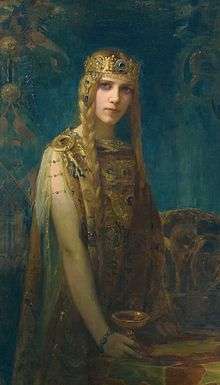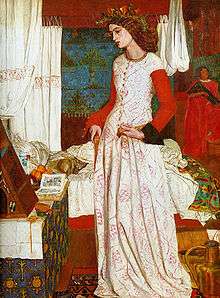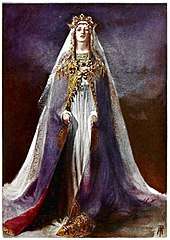Iseult
Iseult (/ɪˈsuːlt, ɪˈzuːlt/), alternatively Isolde (/ɪˈsoʊld(ə), ɪˈzoʊld(ə)/), is the name of several characters in the legend of Tristan and Iseult. The most prominent is Iseult of Ireland, wife of Mark of Cornwall and lover of Tristan. Her mother, the Queen of Ireland, is also named Iseult. The third is Iseult of the White Hands, the daughter of Hoel of Brittany, sister of Kahedin, and eventual wife of Tristan.

Name
Her name is variously given as Iseult, Isolde, Yseult, Ysolt, Isode, Isoude, Iseut, Isaut (Old French), Iosóid (Irish), Esyllt (Welsh), Isolda (Spanish), Isotta (Italian). The oldest source, Béroul's 12th-century romance, spells her name as Yseut or Iseut. The etymology is uncertain, with most sources linking it to the Old High German words īs ("ice") and hiltja ("battle").[1][2] Other writers derive it from a Brythonic *Adsiltia, "she who is gazed upon."[3][4]
Iseult of Ireland

The Irish princess, Iseult of Ireland (also Iseult La Belle or Iseult la Blonde, "Iseult the Fair"), is the daughter of King Anguish of Ireland and Queen Iseult the Elder. She is a main character in the Tristan poems of Béroul, Thomas of Britain, and Gottfried von Strassburg and in the opera Tristan und Isolde by Richard Wagner.
Iseult is first seen as a young princess who heals Tristan from wounds he received fighting her uncle, Morholt. When his identity is revealed, Tristan flees back to his own land. Later, Tristan returns to Ireland to gain Iseult's hand in marriage for his uncle, King Mark of Cornwall. She is betrothed to an evil steward who claims to have killed a dragon and displays its head, but when Tristan proves he killed the dragon by showing that he already took its tongue, Iseult's parents agree to let him take her to Mark. On the journey back to Cornwall, Iseult and Tristan accidentally drink a love potion prepared for her and Mark by Iseult and guarded by Brangaine, Iseult's lady-in-waiting. The two fall hopelessly in love, and begin an affair that ends when Mark banishes Tristan from Cornwall.
In the verse tradition, the lovers do not meet again until Tristan is on his death bed (see below), but in the later Prose Tristan and works based upon it, Tristan returns from Brittany and they resume their affair. Mark is much less sympathetic in these versions, and the lovers eventually flee from his wrath. Lancelot gives them refuge in his estate Joyous Garde, and they engage in many further adventures.
In the prose versions, the lovers' end comes when Mark finds them as Tristan plays the harp for Iseult beneath a tree. The cruel king stabs his nephew in the back, and Tristan, at Iseult's request, fatally crushes his beloved in a tight embrace as his final act. One of her rumored burial sites is Chapelizod in Dublin, Ireland.
Iseult of Brittany

After King Mark learns of the secret love affair between Tristan and Iseult, he banishes Tristan to Brittany, never to return to Cornwall. There, Tristan is placed in the care of Hoel of Brittany after receiving a wound. He meets and marries Hoel's daughter, Iseult Blanchmains (Iseult "of the White Hands"), because she shares the name of his former lover. They never consummate the marriage because of Tristan's love for Iseult of Ireland.
During one adventure in Brittany, Tristan suffers a poisoned wound that only Iseult of Ireland, the world's most skilled physician, can cure. He sends a ship for her, asking that its crew fly white sails on the return if Iseult is aboard, and black if she is not. Iseult agrees to go, and the ship races home, white sails high. However, Tristan is too weak to look out his window to see the signal, so he asks his wife to check for him. In a moment of jealousy, Iseult of the White Hands tells him the sails are black, and Tristan expires immediately of despair. When the Irish Iseult arrives to find her lover dead, grief overcomes her, and she passes away at his side.
This death sequence does not appear in the Prose Tristan. In fact, while Iseult of the White Hands figures into some of the new episodes, she is never mentioned again after Tristan returns to Cornwall, although her brother Kahedin remains a prominent character. The plot element of the fatal misunderstanding of the white and black sails is similar to—and might have been derived from—the story of Aegeus and Theseus in Greek mythology.
Modern portrayals
- Iseult of Ireland (as Isolde) was played by Sophia Myles in the 2006 film adaptation, Tristan & Isolde.
- Isolde is confused with Minerva in the 1960 film by Jean Cocteau, The Testament of Orpheus.
- Author, scholar and historian Rosalind Miles wrote a trilogy of fictional novels based upon the romance of Iseult, beginning with Isolde: Queen of the Western Isle (2002), followed by The Maid of the White Hands (2005), and concluding with The Lady of the Sea (2005).
- German composer Richard Wagner composed the opera Tristan und Isolde based upon Tristan, a tale of chivalrous romance. It was written by Gottfried von Strassburg during the Middle Ages in Middle High German.
- Iseult was played by Irish actress Charlie Murphy in The Last Kingdom, a British historical fiction television series based on Bernard Cornwell's The Saxon Stories series of novels where Iseult hails from Kernow or Cornwalum (modern Cornwall). She acts as a 'shadow queen' for one of the remaining Briton pagan kings in Britain.
References
- Mackensen, Lutz (June 27, 1988). "Das grosse Buch der Vornamen: Herkunft, Ableitungen und Verbreitung, Koseformen, berühmte Namensträger, Gedenk- und Namenstage, verklungene Vornamen". Ullstein – via Google Books.
- Kohlheim, Rosa; Kohlheim, Volker (March 1, 2016). "Lexikon der Vornamen: Herkunft, Bedeutung und Gebrauch von über 8 000 Vornamen". Bibliographisches Institut GmbH – via Google Books.
- Bromwich, Rachel (November 15, 2014). "Trioedd Ynys Prydein: The Triads of the Island of Britain". University of Wales Press – via Google Books.
- Ellis, Peter Berresford (June 27, 1996). "Celtic Women: Women in Celtic Society and Literature". W.B. Eerdmans Pub. – via Google Books.
Sources
| Wikimedia Commons has media related to Tristan and Iseult. |
- Ronan Coghlan The Illustrated Encyclopedia of Arthurian Legends, New York, 1993.
- Norris J. Lacy (editor) The New Arthurian Encyclopedia, New York: Garland, 1996.